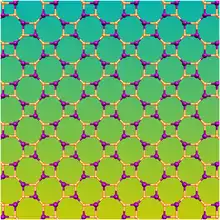
Haeckelite 8–4 structure containing square and octagonal rings[1]
Haeckelites are three-fold coordinated networks of carbon atoms generated by a periodic arrangement of pentagons, hexagons and heptagons. They were first proposed by Humberto and Mauricio Terrones and their colleagues in 2000.[2] They were named in honour of Ernst Haeckel, whose diagrams of radiolaria contained similar structural features. They have not yet been synthesised in the laboratory, but have been the subject of a considerable amount of theoretical work.
References
Wikimedia Commons has media related to Haeckelites.
- ↑ Camacho-Mojica, Dulce C.; López-Urías, Florentino (2015). "GaN Haeckelite Single-Layered Nanostructures: Monolayer and Nanotubes". Scientific Reports. 5: 17902. Bibcode:2015NatSR...517902C. doi:10.1038/srep17902. PMC 4674713. PMID 26658148.
- ↑ Terrones, H; Terrones, M; Hernandez, E; Grobert, N; Charlier, J. C.; Ajayan, P. M.; et al. (2000). "New Metallic Allotropes of Planar and Tubular Carbon" (PDF). Physical Review Letters. 84 (8): 1716–1719. Bibcode:2000PhRvL..84.1716T. doi:10.1103/physrevlett.84.1716. PMID 11017608.
This article is issued from Wikipedia. The text is licensed under Creative Commons - Attribution - Sharealike. Additional terms may apply for the media files.